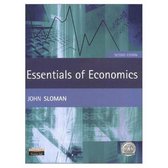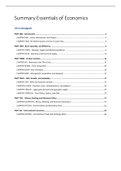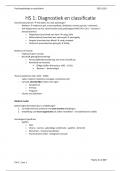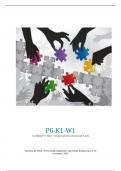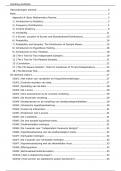Inhoudsopgave
PART ONE - Introduction................................................................................................................................. 2
CHAPTER ONE - Limits, Alternatives, and Choices ............................................................................................... 2
CHAPTER TWO- The Market System and the Circular Flow................................................................................. 6
PART TWO - Price, Quantity, and Efficiency .................................................................................................... 9
CHAPTER THREE - Demand, Supply and Market Equilibrium .............................................................................. 9
CHAPTER FOUR - Elasticity of demand and Supply ........................................................................................... 12
PART THREE - Product markets ..................................................................................................................... 14
CHAPTER SIX – Businesses and Their Costs ....................................................................................................... 14
CHAPTER SEVEN – Pure Competition ................................................................................................................ 20
CHAPTER EIGHT- Pure monopoly ...................................................................................................................... 26
CHAPTER NINE - Monopolistic competition and oligopoly ................................................................................ 31
PART FOUR – GDP, Growth, and Instability ................................................................................................... 37
CHAPTER TEN – GPD, and Economic Growth .................................................................................................... 37
CHAPTER ELEVEN – Business cycles, Unemployment, and Inflation ................................................................. 42
CHAPTER TWELVE – Aggregate demand and aggregate supply ....................................................................... 47
CHAPTER THIRTEEN – Fiscal Policy, Deficts, and Debt ...................................................................................... 53
PART FIVE – Money, Banking and Monetary Policy ....................................................................................... 57
CHAPTER FOURTEEN – Money, Banking, and Financial Institutions ................................................................. 57
CHAPTER FIFTEEN – Interest Rates and Monetary Policy.................................................................................. 61
PART SIX – International Economics.............................................................................................................. 64
CHAPTER SIXTEEN – International Trade and Exchange Rates ......................................................................... 64
,PART ONE - Introduction
CHAPTER ONE - Limits, Alternatives, and Choices
Leerdoelen:
• Define economics
• Describe the role of economic theory
• Microeconomics vs marcoeconomics
• List the categories of scarce resources
• Production possibilities analysis, increasing opportunity costs, economic growth
• Understand graphs, curves and slopes in relation to economics.
Economics:
• Wants
• Means
In the modern world people want a lot of things we don't actually need.
Resources: labour, managerial talent, tools, machinery, land, mineral deposits
These help us produce goods and services that satisfy many of our economic wants.
Our economic want far exceeds the productive capacity of our scarce limited resources.
Because of this we are forced to make choices.
Economics = the social science concerned with how individuals, institutions and society make choices
under conditions of scarcity.
The Economic perspective
Economic perspective = A viewpoint that envisions individuals and institutions making rational
decisions by comparing the marginal benefits and marginal costs of their actions.
Scarcity (schaarste) and choice
Economists can view the world through the lens of scarcity. Scarce economic resources mean limited
goods and ser- vices. Scarcity restricts options and demands choices. Because we “can’t have it all,”
we must decide what we will have and what we must forgot.
In these choices we make sacrifices, because the resources could also have been used to produce
something else, these sacrifices are called: opportunity costs: The value of the good, service, or time
forgone to obtain something else.
Bv: Bill Gates (stopped college and created microsoft later) understood opportunity costs and made
their choices accordingly. The size of opportunity costs greatly matters in making individual decisions.
Purposeful behaviour
Human behaviour reflects "rational self-interest". They will always look for and pursue opportunities
to increase their utility: The satisfaction obtained from consuming a good or service. Oa. please,
happiness or satisfaction. Because they weigh the costs and benefits, their decisions are purposeful
and rational and not random.
Purposeful behaviour does not assume that people and institutions are immune from faulty logic and
therefore are perfect decision makers. It simply means that people make decisions with some
desired outcome in mind.
It is not the same as selfishness. We will find that increasing one’s own wage, rent, interest, or profit
normally requires identifying and satisfying somebody else’s want. Also, many people make personal
,sacrifices to others without expecting any monetary reward. Think about charities and parents who
pay stuff for their children.
Self-interested behavior is simply behavior designed to increase personal satisfaction, however it
may be derived.
Marginalism: comparing Benefits and Costs
Marginal analysis = The comparison of marginal (“extra” or “additional”) benefits and marginal costs,
usually for decision making.
Marginal means extra or additional or a change in. In choices that involve changes in the status quo,
this is quite common.
Bv: should you study an extra hour for your exam?
Each option involves extra benefits and extra costs. When making a rational choice, the decision
maker must compare those two. If the marginal benefit is bigger then the marginal cost you should
do the 'bigger' option. If the marginal cost is more than the marginal benefit you shouldn't do it.
Theories, Principles, and Models
Economics relies on the scientific method: The systematic pursuit of knowledge by observing facts
and formulating and testing hypotheses to obtain theories, principles, and laws.
• Observing behavior and outcomes
• Formulating a possible explanation = hypothesis
• Testing the hypoothesis by comparing the outcomes to the predicted outcomes.
• Accepting, rejecting or modifying the hypothesis.
• Continuiing to test the hypoothesis. The hypothesis can evolve into a theory, and if its very
well tested and accepted it willl be a lw or principle.
Principles: statements about economic behavior that enable prediction of the probable effects of
certain actions.
They are "purposeful simplifications". In developing theories and principles, economists remove the
clutter and simplify. Good theories do a good job of explaining and predicting.
About economics principles:
• Generalizations
• Other-things-equal assumption: the assumption that factors other than those being
considered do not change.
• Graphical expression: economic models are expressed graphically.
Microeconomics and Macroeconomics
Microeconomics
The part of economics concerned with individual decision-making units, sush as a consumer, a
worker or a business firm.
Macroeconomics
The part of economics concerned with the economy as a whole or major components of the
economy.
Aggregate: a collection of specific economic united treated as if they were one unit. For example : all
the U.S. consumers. This seeks to obtain an overview or general outcome.
Individual's economic problem
Economic problem: the need for individuals and society to make choices because wants exceed
means.
, Limited income
Everyone has a limit amount of income.
Unlimited wants
Most people have virtually unlimited wants. We desire various goods and services. It varies from
necessities (food, shelter, clothing) to luxuries (movies, perfumes, cars).
There is a difference between services and goods. We also buy a lot of goods for their services, such
as a car or a washing machine.
Because we have a limited income and unlimited wants it is in our self-interest to economize: pick
and choose goods and services that maximize our satisfaction. We need to make choices.
A budget Line
A line that shows various combinations of two products a consumer can purchase with a specific
money income, given the products prices.
For example: a DVD is 20 dollars and a book is 10 dollars. The person has a 120 dollars to spend, their
consumer budget line will look like this:
The combinations left or inside the line are attainable, the person can afford to buy that. In contrast,
all combinations beyond the budget line are unattainable.
Trade-offs and opportunity costs
Trade-offs: to obtain more DVDs you have to give up some books. It illustrators the idea of trade-offs
arising from limited income.
It also indicated the constant opportunity cost: an opportunity cost that remains the same as
consumers shift purchases form one product to another along a straight line budget line.
Choice: limited income forces people to choose what to buy and what not the buy. This choice will
probably be different per person.
Income changes: the line will shift if the persons income changes.
Society's economic problem


